U.S. Army Vietnam War Manhattan, IL Flight date: 04/05/23
By Al Konieczka, Honor Flight Chicago Veteran Interview Volunteer
Richard Rock grew up in Joliet, Illinois. His grandfather fought in World War I, his father in World War II and he had three brothers who served. At the age of 19, while attending Joliet Jr. College, Richard got drafted. Richard remembered, “I never really chose the Army. I reported to Chicago along with many other young men, we stood in a line and we counted off. That determined what branch of the service we were going into. The guy on my right went to the Navy, I went to the Army and the guy on my left went to the Marine Corp.“
Richard, or “Rock” as people referred to him, did his 8 week basic training at Fort Polk, Louisiana. Afterwards he went to Fort Ord in California for three weeks of Advanced Individual Training (AIT). Richard recalled, “My specialty was 81mm mortars. For three weeks in a row we went to the mortar range. Every day, mornings and afternoons, it was always the same settings for elevations and deflections. When they tested us, after the first round I would set the gun before instruction for the second round and the Sergeant would ask me, ‘How do you know what settings to use before we tell you?’ I said, it’s the same every day so I’m used to it and have it memorized.”
Richard maxed out on the final test with 100% score. Those who aced the test were given the opportunity to go to a school called Davy Crockett. Davy Crockett was a small tactical nuclear weapon that would take out everything from ground zero a half a mile in all directions. Richard explained, “It was meant for infantry soldiers. And for that training, they would have sent me back to Fort Polk. It was set up for one man to fire. When I saw a picture of it, I thought to myself, this is crazy! They want me to launch a nuclear weapon and kill who knows how many people and destroy the land and animals. So I re-took the test and got a 60% – I flunked it on purpose. As a Christian, I couldn’t see myself firing that weapon.”
So the First Sergeant gave Richard a choice. He showed him a map of Vietnam and told him to pick out one of the patches on the map because that’s where he would be going. So Richard noted, “On the bottom of the map was the First Infantry Division in the Delta. I said, that’s Lee Marvin’s unit, I remember the WWII movie The Big Red One, so I made that my first choice and my second choice was First Calvary Division Air Mobile and that’s actually where I ended up.”
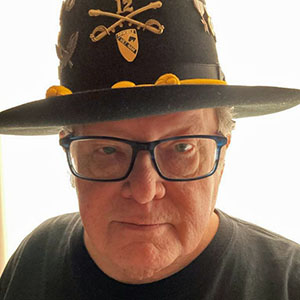
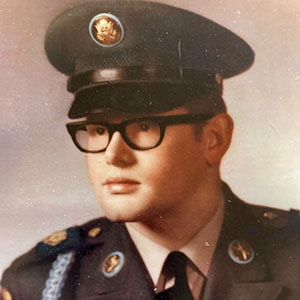
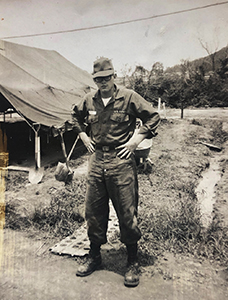
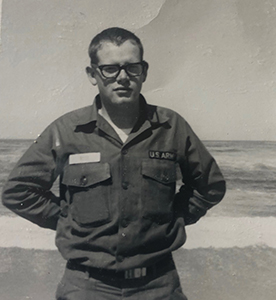
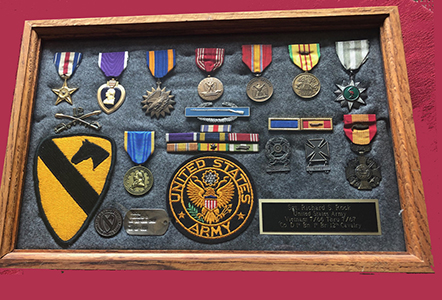
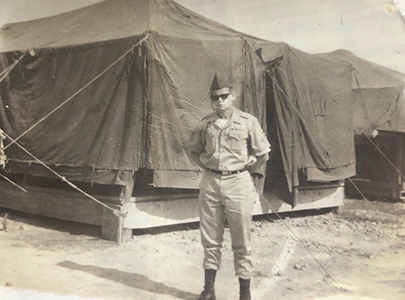
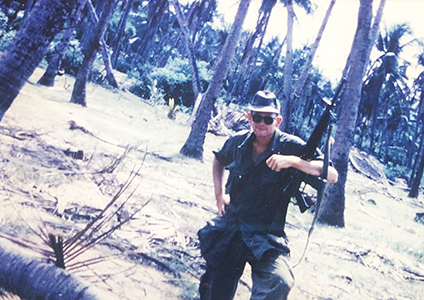
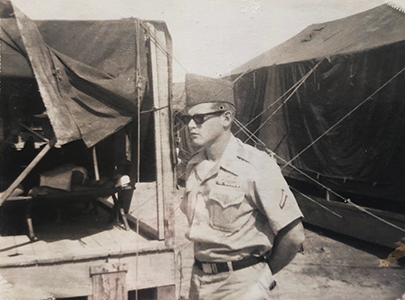
Richard recalled when he first got to Vietnam, “I never thought when I was going to Vietnam that I would ever see combat. When I got there, they put me in the mess hall. My job was to serve the officers and put out their nice china and polished silverware. I would start at 5am and leave about 7pm. After a week of this, I thought, this is killing me. I’m walking back from the mess hall after dark one night and the North Vietnamese are shooting mortars at us. The sky was all lit up and I was fascinated with it all. As I get back to the Company, the First Sergeant yells at me to get in the trench. As I get in the trench, a black guy was in the trench praying ‘Jesus get me out of this field, help me God’. I grabbed him by the collar and dragged him back to where the First Sergeant was and said, ‘This man wants to work in the mess hall and I’m going to take his place in the field – whatever he does, I’m now doing it’. So we switched jobs and the next morning I was on a helicopter flying out to the front lines as a radio operator.”
On his first mission in the field as a mortar platoon, they went up on a big hill and started digging three pits for the mortar tube and then fox holes around it for protection. Their Platoon Sergeant always wanted them to be busy so they also dug trenches between the mortar pits and the fox holes. Richard laughed as he said, “I felt like a mole, all I was doing was digging holes. Now my foxhole buddy was 6 foot six inches tall and I’m 5 foot 7 inches tall so I couldn’t even get out of our foxhole without help.”
Within two weeks his mortar team became a rifle company. They started walking on patrol through the jungles, the highlands, the plains, everywhere. He has no idea how many miles he walked while in Vietnam. They never slept in the same place two nights in a row. Richard seemed to be a natural leader. They ambushed every night and Richard did a lot of long range reconnaissance patrols with himself and four other soldiers. While he was only a PFC, the lowest ranking man in the company, he was always put in charge of the men he went out with. They all listened to him, trusted and respected him.
When he had the opportunity he walked point; he liked walking point because he didn’t have to carry the heavy radio. Most of their firefights were small. However, in November 1966, his company got into a battle called Hoa Hoi for which they received a Presidential Unit Citation. “The first day of the battle we asked the enemy to surrender but they didn’t. We called in three more companies. We had them surrounded. We pushed them back and followed them in. A helicopter dropped psychological leaflets so if the enemy picked one up and waved it, we wouldn’t shoot them. We took about 30 prisoners and pushed the rest out to the beach where there was no cover and we killed them all there.”
Richard was about to encounter the toughest battle of his life. “A month later in December 1966, we got into a battle for the 506 Valley near Bong Son. There was already a company engaged with the enemy when they called in additional companies. We flew in by helicopter. It was dark as we moved through the hedge rows and every so often saw there was an opening. As we got to the fourth row of hedges, we were all kneeling down making sure everyone was together. As I made my way forward through the thick jungle, I got my foot caught on what we called the wait a minute vine. I had to stop and untangle my foot and fell a few feet behind the rest of the group. About two steps from the next opening, the enemy opened up on us.”
Richard explained that his Platoon Leader and Squad Leader were both off to his right when the shooting began. “I saw six bullets hit my Platoon Sergeant in the head, the official record reads twelve. My Squad Leader took two shots to the chest as well as a hand grenade wound. Everybody that I could see was going down. I ran forward to the next set of bushes and I knew there were snipers in the trees. I could see bullets hitting around me and I knew they could see me so I took my radio off, set my M-16 to fully auto and started spraying every tree in front of me and to the left and right. I shot out 12 magazines into the trees. Then I ran over to the nearest dead guy and grabbed his ammo, since I was out.”
Once Richard had things under control, he went around and patched up ten of the wounded soldiers. He gave them each a pistol or a rifle and told them where to look and said if anyone comes through that area, you kill them. He then realized he needed to get them out of that area. He found an M-79 grenade launcher that he used to take out the enemy bunker that had been firing on them. “I got right in front of the bunker and stood up and fired but I missed the bunker twice. On the third shot I took my time, held my breath and pulled the trigger and blew it up. That ended the firing from that bunker.”
Richard then showed the wounded who were able to walk the way back to the rice paddy so they could get medevacked out. He carried the others out and then stayed behind because there were still two others on the battle field, his Squad Leader and a medic. Under covering machine gun fire from his Lieutenant, Richard and another soldier ran out and each were able to drag one man out to get them to safety. The entire battle lasted about 7 hours. Richard received the Silver Star for valor, the third highest military award, for his efforts that day.
Once everyone had been cleared from the battle field, they pulled back 100 yards and the Lieutenant asked for volunteers to go back to recover weapons and equipment. Of course Richard and four others volunteered to go back, even though the enemy still controlled the area. He was told a few days later that they were outnumbered by the enemy 12 to 1 in that battle.
Richard was wounded in a later battle when a gun shot hit the top of a hand grenade on his belt and detonated. He received surgery and stitches and was in the hospital for 10 days. His injury prevented him from returning to active duty, despite his desire to do so. He was sent back to a designated landing zone and put in charge of a re-supply unit for the company. He worked there for weeks and then went back to base camp to process out of the Army. He spent a total of one year in Vietnam.
When he returned to the US, he went to Fort Hood to get evaluated and they wouldn’t clear him to do anything so they were going to discharge him. Rock refused to leave because he had signed up for two years and stayed five more months. At one point he was put on a garbage detail. Richard was an avid fossil hunter and would do this for two hours while on garbage detail. He even added another foot locker in the barracks to hold all of the fossils he collected.
Richard held many different jobs upon his return home. He worked at a local drive-in theater, Caterpillar Tractor, as an electrician and at Petco as a maintenance man. He married his current wife Peggy in 2022 and has three children and five grandchildren. He’s a master gardener, serves as a volunteer at The Chicago Academy of Sciences and is an avid prospector. He’s even been to Nome, Alaska numerous times prospecting for gold.
Richard served in Vietnam from July 1966 to July 1967. He’s thankful to God for protecting him while in Vietnam. He earned a number of awards, medals, honors and certifications during his enlistment. He is very much looking forward to his Honor Flight!
Thank you Richard for your years of dedicated service. Enjoy your well-deserved trip to Washington D.C.!


